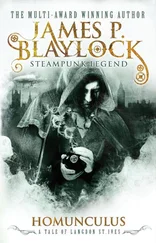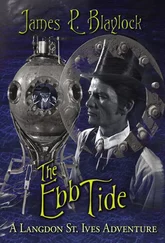He was possessed, said Priestly, with the idea of one day docking at Marseilles or London and striding ashore flanked by an army of the unlikely offspring of two of the most ludicrous beasts imaginable, throwing the same fear into the civilized world that Hannibal must have produced when, with ten score of elephants, he popped in from beyond the Alps. Narbondo, however, was never seen again. He docked in Surabaja, disappeared into the jungles with his beasts, and, as they say of Captain England in Mauritius, went native. Whether Narbondo became, in the years that followed, the fabled Wildman of Borneo is speculation. Some say he did, some say he died of typhus in Bombay. His hippopotami, however, riddled with Narbondo’s serum, multiplied-within a small area of Eastern Java.
The explanation of the existence of the hippos seemed to whet St. Ives’s curiosity. He questioned Priestly for an hour, in fact, about this mysterious Doctor Narbondo, but Priestly had merely read about the mad doctor in Ashbless’s Account of London Madmen (a grossly unfair appellation, at least in regard to Doctor Narbondo) and he could remember little else.
St. Ives, Hasbro, and I, of course, already knew of the existence of this Narbondo, and of his secret identity, for he was not, as Frosbinder alleged, Ignacio Narbondo, who lies frozen in a Scandanacian Tarn. He was (and still is) Ignacio Narbondo’s long lost twin brother Ivan, who had stolen his brother’s name and traded on his reputation before the name and reputation fell into disrepute. His flight from England had less to do with vivisection than with the sworn enmity of the enraged Ignacio, an enmity that is now long cooled, if you’ll allow me a moment of levity.
Half a dozen times that night I awakened to the sounds of something crashing in the forest above, and twice, blinking awake, I saw wide, hairy faces, upside down, eyes aglow, peering at us from overhead — jungle beasts, hanging from the vine-covered ledge above to watch us as we slept. Visions of the supposed Narbondo’s hippo-apes flitted through my dreams, and when daylight wandered through the following morning, I was convinced that many of the past night’s visitations had not been made merely by the creatures of dreams, but had actually been the offspring, so to speak, of the misanthropic Doctor Narbondo.
We had a brief respite from the rain that morning, and, determined to make the most of it, we loaded our gear aboard the piroques and prepared to clamber in. The sun broke through the clouds about then, and golden rays slanted through the forest ceiling, stippling the jungle floor and setting off an opera of bird cries and monkey whistling. We stood and stared at the steamy radiance of the forest, beautiful beyond accounting, then turned toward the canoes. A shout from Hasbro, however, brought us up short. He’d seen something, that much was certain, in the jungle beyond the riverside cavern.
“What ho, man?” said St. Ives, anxious to be off yet overwhelmed with scientific curiosity.
“A temple of sorts, sir,” said Hasbro, pointing away into the forest. “I believe I see some sort of stone monolith or altar, sir. Perhaps a shrine to some heathen god.”
And sure enough, bathed now in sunlight was a little clearing in the trees. In it, scattered in a circle, were half a dozen stone rectangles, one almost as large as an automobile, all crumbling and half-covered with creepers and moss.
Bill Kraken, still suffering from the poulp madness that had so befuddled him in the past months, gave out a little cry and dashed past Hasbro up the bank and into the forest. The rest of us followed at a run, fearing that Bill would come to harm. If we had known what lay ahead, we would have been a bit quicker about it even yet.
What we found in the clearing was that circle of stone monoliths, crumbling, as I’ve said, with age. Dozens of bright green asps rested in the sunshine atop the stones, watching us through lazy eyes. Four wild pigs, rooting for insects, crashed off into the vegetation, setting off the flight of a score of apes which had, hitherto, been hidden away overhead in the treetops. In the midst of the circle of stones sat a peculiar and indescribably eerie statue, carved, it seemed, entirely of ivory. It was old, though clearly not so old as the monoliths surrounding it, and it was minutely carven; its mouth looked as if it were ready to speak, and its jaw was square and determined and revealed just a hint of sadness. On closer inspection it clearly wasn’t ivory that it had been carved from, for the stone, whatever it was, was veined with thin blue lines.
It was uncanny. Professor St. Ives speculated at first that it was some sort of rare Malaysian marble. And very fine marble at that — marble that Michelangelo would have blathered over. More astonishing than the marble, though, were its eyes — two great rubies, faceted so minutely that they threw the rays of the tropical sun in a thousand directions. And it was those ruby eyes that not only cut short our examination of the ruined ring of altars and the peculiar idol, but which were the end of poor old Bill Kraken, a fine scientist in his own right before falling into the hands of the aliens after Birdlip’s demise.
It was the flash of sunlight from those rubies that had instigated Kraken’s charge up the slope and into the clearing. While the rest of us had gathered about commenting on the strange veined stone, Bill had stood gaping, clutching his umbrella, hypnotized by the ruby lights which, as the forest foliage swayed in the breezes overhead, now shading the jungle floor, now opening and allowing sunlight to flood in upon us, played over his face like the glints of light thrown from one of those spinning mirrored globes that dangle from the ceiling of a ballroom.
Suddenly and in an instant, as if propelled from a catapult, he sprang past St. Ives, hurled Priestly aside, and jabbed the tip of his umbrella in under one of the ruby eyes — the left eye, it was; I remember it vividly. He pried furiously on the thing as St. Ives and Hasbro attempted to haul him away. But he had the strength of a madman. The eye popped loose, rolling into the grasses, and Mad Bill shook off his two friends, wild in his ruby lust. He cast down his umbrella and dived for the gem, convinced, I suppose, that St. Ives and Hasbro and, no doubt, Priestly and myself were going to wrestle him for it. What brought him up short and froze the rest of us to the marrow there in that steamy jungle sun was a long, weary, ululating howl — a cry of awful pain, of indefinable grief — that soared out of the jungle around us, carried on the wind, part of the very atmosphere.
Our first thought after that long frozen instant was, of course, of cannibals. Bill snatched up the stone and leapt down the path toward the piroques with the rest of us, once again, at his heels.
Before night fell we had paddled out into the Bali Straits, never having caught a glimpse of those supposed cannibals nor seen the hint of a flying spear. There lay the Dutch freighter the Peter Van Teeslink. A week later Bill Kraken died of a fever in Singapore, shouting before he went of wild jungle beasts and of creatures that lay waiting for him in the depths of the sea and of a grinning sun that blinded him and set him mad.
We buried him there in Singapore on a sad day. St. Ives was determined to bury the ruby with him — to let him keep the plunder which had, it seemed certain, brought about his ruination. But Priestly wouldn’t consider it. The ruby alone, he said, would pay for the entire journey with some to spare. To bury it with Kraken would be to submit, as it were, to the lusts of a madman. And Kraken, only six months previously, had been as sane as any of us. Keep the ruby, said Priestly. If nothing else it would provide for Kraken’s son, himself almost as mad as his father. Hasbro agreed with Priestly as did, after consideration, St. Ives. The Professor, I believe, had an uncommon and inexplicable (in the light of his scientific training) fear of the jewel. But that’s just conjecture. In the forty-five years I’ve known him he’s demonstrated no fears whatsoever. He’s too full of curiosity. And the ruby, finally, was a curiosity. It was certainly that.
Читать дальше












